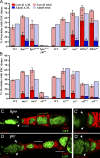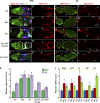Coupling of Hedgehog and Hippo pathways promotes stem cell maintenance by stimulating proliferation
- PMID: 24798736
- PMCID: PMC4018789
- DOI: 10.1083/jcb.201309141
Coupling of Hedgehog and Hippo pathways promotes stem cell maintenance by stimulating proliferation
Abstract
It is essential to define the mechanisms by which external signals regulate adult stem cell numbers, stem cell maintenance, and stem cell proliferation to guide regenerative stem cell therapies and to understand better how cancers originate in stem cells. In this paper, we show that Hedgehog (Hh) signaling in Drosophila melanogaster ovarian follicle stem cells (FSCs) induces the activity of Yorkie (Yki), the transcriptional coactivator of the Hippo pathway, by inducing yki transcription. Moreover, both Hh signaling and Yki positively regulate the rate of FSC proliferation, both are essential for FSC maintenance, and both promote increased FSC longevity and FSC duplication when in excess. We also found that responses to activated Yki depend on Cyclin E induction while responses to excess Hh signaling depend on Yki induction, and excess Yki can compensate for defective Hh signaling. These causal connections provide the most rigorous evidence to date that a niche signal can promote stem cell maintenance principally by stimulating stem cell proliferation.
Figures






Similar articles
-
The Hippo pathway acts downstream of the Hedgehog signaling to regulate follicle stem cell maintenance in the Drosophila ovary.Sci Rep. 2017 Jun 30;7(1):4480. doi: 10.1038/s41598-017-04052-6. Sci Rep. 2017. PMID: 28667262 Free PMC article.
-
Yorkie and Hedgehog independently restrict BMP production in escort cells to permit germline differentiation in the Drosophila ovary.Development. 2017 Jul 15;144(14):2584-2594. doi: 10.1242/dev.147702. Epub 2017 Jun 15. Development. 2017. PMID: 28619819 Free PMC article.
-
The Hippo pathway integrates PI3K-Akt signals with mechanical and polarity cues to control tissue growth.PLoS Biol. 2019 Oct 15;17(10):e3000509. doi: 10.1371/journal.pbio.3000509. eCollection 2019 Oct. PLoS Biol. 2019. PMID: 31613895 Free PMC article.
-
A role for Hipk in the Hippo pathway.Sci Signal. 2013 May 14;6(275):pe18. doi: 10.1126/scisignal.2004259. Sci Signal. 2013. PMID: 23674821 Review.
-
Mutual regulation between Hippo signaling and actin cytoskeleton.Protein Cell. 2013 Dec;4(12):904-10. doi: 10.1007/s13238-013-3084-z. Epub 2013 Nov 18. Protein Cell. 2013. PMID: 24248471 Free PMC article. Review.
Cited by
-
Communication between the stem cell niche and an adjacent differentiation niche through miRNA and EGFR signaling orchestrates exit from the stem cell state in the Drosophila ovary.PLoS Biol. 2024 Mar 21;22(3):e3002515. doi: 10.1371/journal.pbio.3002515. eCollection 2024 Mar. PLoS Biol. 2024. PMID: 38512963 Free PMC article.
-
Fruit flies exploit behavioral fever as a defense strategy against parasitic insects.Sci Adv. 2025 Jun 13;11(24):eadw0191. doi: 10.1126/sciadv.adw0191. Epub 2025 Jun 11. Sci Adv. 2025. PMID: 40498848 Free PMC article.
-
The Hippo pathway acts downstream of the Hedgehog signaling to regulate follicle stem cell maintenance in the Drosophila ovary.Sci Rep. 2017 Jun 30;7(1):4480. doi: 10.1038/s41598-017-04052-6. Sci Rep. 2017. PMID: 28667262 Free PMC article.
-
Differential control of Yorkie activity by LKB1/AMPK and the Hippo/Warts cascade in the central nervous system.Proc Natl Acad Sci U S A. 2015 Sep 15;112(37):E5169-78. doi: 10.1073/pnas.1505512112. Epub 2015 Aug 31. Proc Natl Acad Sci U S A. 2015. PMID: 26324895 Free PMC article.
-
Non-apoptotic caspase activation ensures the homeostasis of ovarian somatic stem cells.EMBO Rep. 2023 Jun 5;24(6):e51716. doi: 10.15252/embr.202051716. Epub 2023 Apr 11. EMBO Rep. 2023. PMID: 37039000 Free PMC article.
References
Publication types
MeSH terms
Substances
Grants and funding
LinkOut - more resources
Full Text Sources
Other Literature Sources
Medical
Molecular Biology Databases

